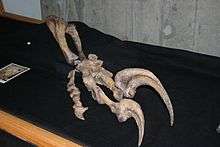Megaraptor
| Megaraptor Temporal range: Late Cretaceous,[1] 91–88 Ma | |
|---|---|
| | |
| Claw cast with a ruler for scale | |
| Scientific classification | |
| Kingdom: | Animalia |
| Phylum: | Chordata |
| Class: | Reptilia |
| Clade: | Dinosauria |
| Order: | Saurischia |
| Suborder: | Theropoda |
| Family: | †Neovenatoridae |
| Clade: | †Megaraptora |
| Genus: | †Megaraptor Novas, 1998 |
| Species: | †M. namunhuaiquii |
| Binomial name | |
| Megaraptor namunhuaiquii Novas, 1998 | |
Megaraptor ("giant thief") is a genus of large theropod dinosaur that lived in the Turonian to Coniacian ages of the Late Cretaceous.[2][3] Its fossils have been discovered in the Patagonian region of Argentina. Initially thought to have been a giant dromaeosaur-like coelurosaur, it was classified as a neovenatorid allosauroid in previous phylogenies, but a more recent phylogeny has placed it as a basal tyrannosauroid coelurosaur. The discovery and phylogeny of Gualicho suggests that Megaraptor is either an allosauroid or basal coelurosaur.[4]
Description

Megaraptor was initially described as a giant dromaeosaur, known primarily from a single claw (about 30 cm long) that resembled the sickle-shaped foot claw of dromaeosaurids.[2] The discovery of a complete front limb, however, showed that this giant claw actually came from the first finger of the hand. In 2010 Gregory S. Paul estimated its length at eight metres, its weight at one tonne.[5] The hands were unusually elongated, bearing sickle-shaped claws even more recurved than those of spinosaurids.[6]
Classification
The hand is quite distinct from other basal tetanurans, so it was not initially clear whether Megaraptor was an allosaurid, a carcharodontosaurid, a spinosauroid, or something else entirely.[3] Subsequent studies, as well as the identification of close relatives with similar large claws on the forelimbs (see below), helped identify Megaraptor as a highly advanced and lightly built allosauroid, and a member of the family Neovenatoridae.[7] More recent studies have proposed that Megaraptor and its kin are actually tyrannosauroids[8] or spinosauroids[9] as opposed to allosauroids.[8] A juvenile specimen described in 2014 has provided more evidence towards Megaraptor being a primitive tyrannosauroid.[10] The discovery of Gualicho indicates that Megaraptor may not be a tyrannosauroid, but either an allosauroid or basal coelurosaur.[11]
When first discovered and prior to publication, the spinosaurid Baryonyx was also reported to be a dromaeosaurid, and the allosauroid Chilantaisaurus was reported to be a possible spinosaurid, both based on the large hand claws.

The cladogram shown below follows an analysis by Porfiri et al., 2014.[12]
| Megaraptora |
| |||||||||||||||||||||
| |
Australian relatives
A close relative of Megaraptor, Australovenator, was discovered in Australia during 2009, helping to solve the mystery of its identity.[7] An additional dinosaur believed to be related to Megaraptor was found in southeastern Australia, Dinosaur Cove. The creature is believed to be around half the size of Megaraptor. It has not yet been named. These finds may show that the breakup of Gondwana was later than once thought.
References
- ↑ Holtz, Thomas R. Jr. (2012) Dinosaurs: The Most Complete, Up-to-Date Encyclopedia for Dinosaur Lovers of All Ages, Winter 2011 Appendix.
- 1 2 Novas, F.E. (1998). "Megaraptor namunhuaiquii, gen. et sp. nov., a large-clawed, Late Cretaceous theropod from Patagonia". Journal of Vertebrate Paleontology. 18: 4–9. doi:10.1080/02724634.1998.10011030.
- 1 2 Calvo, J. O.; Porfiri, J.D.; Veralli, C.; Novas, F.E.; Poblete, F. (2004). "Phylogenetic status of Megaraptor namunhuaiquii Novas based on a new specimen from Neuquén, Patagonia, Argentina". Ameghiniana. 41: 565–575.
- ↑ http://journals.plos.org/plosone/article?id=10.1371/journal.pone.0157793
- ↑ Paul, G.S., 2010, The Princeton Field Guide to Dinosaurs, Princeton University Press p. 99
- ↑ Calvo, J.O., Porfiri, J.D., González-Riga, B.J., and Kellner, A.W. (2007) "A new Cretaceous terrestrial ecosystem from Gondwana with the description of a new sauropod dinosaur". Anais Academia Brasileira Ciencia, 79(3): 529-41.
- 1 2 Benson, R.B.J.; Carrano, M.T; Brusatte, S.L. (2010). "A new clade of archaic large-bodied predatory dinosaurs (Theropoda: Allosauroidea) that survived to the latest Mesozoic". Naturwissenschaften. 97 (1): 71–78. Bibcode:2010NW.....97...71B. doi:10.1007/s00114-009-0614-x. PMID 19826771.
- 1 2 F. E. Novas; F. L. Agnolín; M. D. Ezcurra; J. I. Canale; J. D. Porfiri (2012). "Megaraptorans as members of an unexpected evolutionary radiation of tyrant-reptiles in Gondwana". Ameghiniana. 49 (Suppl.): R33.
- ↑ Holtz, T.R. Jr. (2012). Dinosaurs: The Most Complete, Up-to-date Encyclopedia for Dinosaur Lovers of All Ages. Random House Books for Young Readers. pp. 95–96. ISBN 978-0-375-82419-7.
- ↑ Porfiri, J. D., Novas, F. E., Calvo, J. O., Agnolín, F. L., Ezcurra, M. D. & Cerda, I. A.; Novas; Calvo; Agnolín; Ezcurra; Cerda (2014). "Juvenile specimen of Megaraptor (Dinosauria, Theropoda) sheds light about tyrannosauroid radiation". Cretaceous Research. 51: 35–55. doi:10.1016/j.cretres.2014.04.007.
- ↑ http://journals.plos.org/plosone/article?id=10.1371/journal.pone.0157793
- ↑ Juan D. Porfiri, Fernando E. Novas, Jorge O. Calvo, Federico L. Agnolín, Martín D. Ezcurra and Ignacio A. Cerda (2014). "Juvenile specimen of Megaraptor (Dinosauria, Theropoda) sheds light about tyrannosauroid radiation". Cretaceous Research. 51: 35–55. doi:10.1016/j.cretres.2014.04.007.